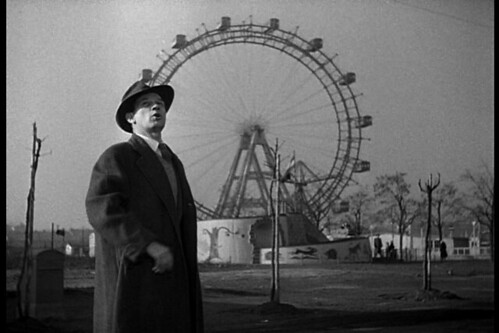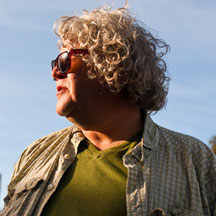Last year, while the first-ever TCM Classic Film Festival took place in Hollywood, I followed the proceedings online from several thousand miles away while seething with envy. This year, I walked 10 minutes from my apartment and experienced it firsthand, and I was in absolute hog heaven. As is the case with many festivals, everyone's experience is different, so I thought I'd share mine.
THURSDAY
I didn't attend any screenings, but I half-coincidentally stumbled upon the red carpet arrivals for the festival. I planted myself on the sidewalk opposite the action, and before long I spotted the silver stallion known as Robert Osborne ("Bobsborne," as I call him). As my boyfriend can tell you, I have an utter obsession with Bobsborne that frequently manifests with me screaming "HE'S A NATIONAL TREASURE!" In all seriousness, though, as the face of TCM he really has done great things for the world of classic cinema, and I know even my boyfriend begrudgingly respects him. Unfortunately, I didn't have my camera, but I savored his classiness from across the street.
Before long I heard two girls behind me wondering what they were witnessing, and I told them. We got to chatting, and I learned that they were visiting from Wisconsin and had only been here for an hour. In that hour they would go on to see more celebrities than I had seen in three months of living in LA. We became celeb-spotting buddies, teaming up with other people around us to deduce the identity of the faraway and partially obscured faces. Ultimately I saw Peter O'Toole, Kate Flannery (Meredith from "The Office"), Ben McKenzie, Tippi Hedren, Ben Mankiewicz (the other TCM host), Illeana Douglas, Priscilla Presley, and Hugh Hefner with his fiancee (also flanked by an additional Playboy Bunny, presumably for symmetry). Later internet research revealed I had also seen Ann Rutherford, Hayley Mills, and Patricia Ward Kelly (Gene Kelly's widow). That sated my craving for celebrity sightings for a while!
 |
| Hef and his ladies (picture courtesy of someone with a significantly better view) |
FRIDAY
I had work during the day, but the night was dedicated to a screening of Spartacus in the legendary Grauman's Chinese Theater - with Kirk Douglas in attendance! Not being a passholder, I got into the line for mere mortals (standby) over an hour early and there were 50 people ahead of me. They managed to get the whole standby line in - no small feat, considering that the 1100-seat venue was completely sold out. I had never been inside the Chinese, and lemme tell ya, they hold all the premieres there for a reason. Bobsborne took the stage, and as far as I was concerned, I was seeing the Beatles circa 1964.
Then Kirk came out, to thunderous applause and a standing ovation. He's slowed down by age and by the stroke he had many years ago, but his mind and wit are as sharp as ever and he has the same twinkle in his eye (or so I presume - I was sitting pretty far back). He was quick to point out that he was only 94 and wouldn't be 95 until December, and finished all his rambling trains of thought with a cheeky "did that answer your question?" Though it's common knowledge to many film buffs, it was great to hear the man himself rehash stories of how his devil-may-care attitude merged with his social conscience to implement changes in Hollywood. Specifically, he recalled his insistence that blacklisted screenwriter Dalton Trumbo be properly credited for Spartacus, and his reaction upon reading the script for Paths of Glory: "This picture won't make a nickel, but we have to do it." Douglas also said that his personal favorite film he did was a 1962 curio called Lonely Are the Brave, where he plays a cowboy unable to adjust to modern life. I've seen the film and didn't really care for it, but Douglas was great as always and I could see how it's a role an actor could really connect with. He concluded by expressing humble gratitude to the hordes of people who came out to see a film he made over 50 years ago.
 |
| Despite the darkness and 10x digital zoom, I assure you that this is Kirk Douglas and Bobsborne. |
The film itself, which I hadn't seen before, was predictably great. The famous Alex North score hooks you from the overture and doesn't let go. Although I have a short attention span and long movies typically make me fidgety, this one held my attention pretty well (although I was rather sleepy at the end from having worked that day). As with most epic films, I enjoyed the first half a lot more, since it contained the origin story part (as compared to the second half of this or any epic, which usually consists of large battles and cramming in huge chunks of time and plot). The film was infamously a director-for-hire gig for Stanley Kubrick and is derided for not being very Kubrickian, but there were definite echoes of Paths of Glory in the stark life-and-death reality of the gladiators' lives. Douglas' charisma anchors the thing, but the supporting cast is one for the ages, and was apparently made possible by Douglas basically lying to each actor about the size of his part. Peter Ustinov in particular stands out, providing comic relief in an Oscar-winning role, as does Charles Laughton and a delightfully miscast Tony Curtis bringing his Noo Yawk accent to ancient Rome. I was glad I hadn't gotten around to seeing the film before, because this was certainly the way to do it!
SATURDAY
I decided that I didn't have the energy for a 9:30 A.M. showing of This Is the Night, so I hung tight until the 3:30 showing of Citizen Kane. It was my fourth or fifth time seeing it, but my first on the big screen. Ben Mankiewicz came out to introduce the film, and while I grumbled at being deprived of my beloved Bobsborne, I had a change of heart after remembering that Kane was cowritten by Mankiewicz' grandfather (which BMank made a point of mentioning several times, as Welles notoriously took full credit).
Also present was Norman Lloyd, an actor who appeared in a range of films as well as being a member of Welles' Mercury Theater. Asked to compare Welles to Hitchcock (who directed Lloyd in Saboteur and Spellbound), Lloyd said that Hitchcock was essentially a storyteller, while Welles was more invested in the theatricality of cinema. He also shared a great anecdote about Welles: upon discovering ex-partner John Houseman's plans to produce a film adaptation of Julius Caesar (which the two had previously staged for the theater), Welles threw a can at Houseman's head in a restaurant and shouted "you stole MY play!" Extreme, sure, but as Lloyd noted, the world needs people who are that passionate about their material.
 |
| Norman Lloyd and Ben Mankiewicz (I promise!) |
Kane was presented as a digital restoration, but I was somewhat disappointed to discover that the picture quality wasn't anything exceptional (maybe it was just me?). Nonetheless, time spent watching Citizen Kane is always time well spent. For the intimidating behemoth of cinema that it seems to be, it's actually quite compulsively watchable (and re-watchable). Once you're familiar with the "meat" of the story, you can savor the little details, like Agnes Moorehead's brief but chilling performance, Jed Leland saying "dramatic crimicism" while drunk, or Bernstein's great anecdote about the lady in the white dress.
From there, I scrambled off to catch Pennies From Heaven. Illeana Douglas introduced the film, which I hadn't seen before, and offered some amusing Christopher Walken stories. Apparently he has a penchant for breaking out into song and dance not only on set, but while cameras are rolling. She also recalled that they used to carpool to a film set together, and one morning he wasn't in the car. About half the ride passed before she realized he was in the backseat, to which he replied in his typical Walken manner "Sometimes I like to disappear. I don't tell anyone."
The film was fantastic, and I'm glad the festival gave it some love. It's pretty much a Fred and Ginger musical with all the harsh realities of life (and the Depression) thrown in - poverty, prostitution, sexual fetishes, adultery, murder, and hopelessness. It sounds like a strange combination - and it is - but it works on a meta level, combining the escapist entertainment of that time with the lives of the suffering people viewing it. Steve Martin is great in the lead, walking a line between pathos and comedy, and is ably supported by Bernadette Peters and Jessica Harper. And let's not forget Christopher Walken, playing a sleazy pimp with a knack for tap dancing. Now, I had heard about his performance in this film and figured that people were grading on a curve - that is, praising his ability because it's more than you'd expect of Christopher Walken. Not so. Had he been born earlier (and had a different mug), he would have been Gene Kelly. Peters and Martin show off their moves too - Martin spent months in training, and it shows. The only thing that was somewhat odd was that none of the actors sang their own songs, despite being notably capable singers. Instead, old recordings are used, which does lend a nice period vibe but still seems like a waste. Also a bummer was that the film print, which was allegedly new in honor of the film's 30th anniversary, looked like a VHS dub. Even though the theater was only about half full, the crowd was great, applauding enthusiastically after every dance number.
 |
| A still from Pennies From Heaven...look familiar? |
In the next installment, I'll cover Saturday night through the end. I know you can only handle so much of me at once.
















